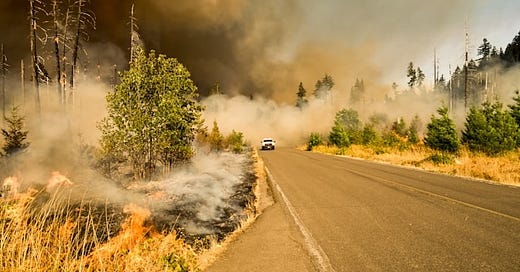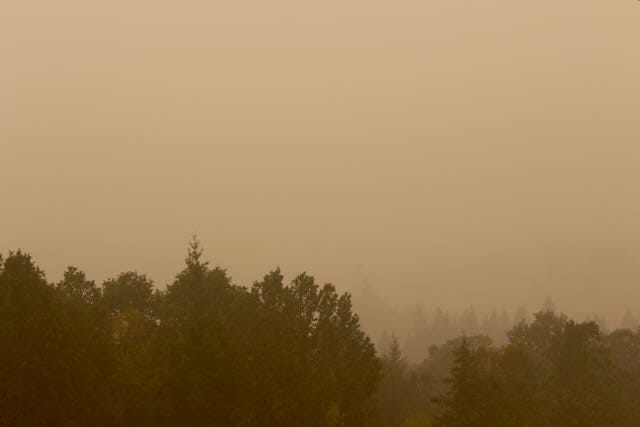Living in the woods was a long-time dream I achieved at age 50. It was easy for me to adjust to a slower lifestyle on my forested homestead. Surrounded by privately owned “timber lands” (clear-cut forests then replanted as tree farms), I considered it my sanctuary and a place of healing and growth. A city gal, I learned much from sharing land with wildlife (I share some of the lessons in Dedicated to the Ones I Love). An introvert, I treasured my solitude while appreciating the small rural village 30 minutes down the mountain. Always a dreamer of possibility and a seeker of stability, I didn’t think about the threat of wildfires when I submitted my offer to buy these five acres in the Cascade foothills.
About seven years ago, that began to change. Summer was the season to celebrate the extraordinary beauty of my homestead and the entire PNW, but the threat of wildfires has dramatically altered the season's joys. Dry lightning strikes can start dozens of fires in one day. Week-long heat waves of triple-digit temps happen at least once in the summer. Private rural lands, once open to locals to hike, forage, and hunt, are now blocked with no trespassing signs due to the potential for wildfire. Campfires are banned on much of the West’s public lands. In 2020, we lived with thick wildfire smoke that kept us inside the house for weeks, requiring masks to walk outside. In June 2021, a weeklong PNW heat wave (with a record-breaking 116F high temperature in Portland) contributed to the deaths of hundreds of people; 70% of them were elderly, who lived alone, and didn’t have air conditioning.
Wildfire smoke engulfed our region for weeks in 2020.
In winter 2012, an ice storm coated the PNW, damaging power lines. My long driveway was a sheet of ice, and the roads were skating rinks. My power was out for five days, so I had no heat or water (the well pump requires electricity). We melted snow on the woodstove (our only source of heat). The first day or two, my son and I joked about living like pioneers. By day five, we were no longer amused by the reality TV version of the “good ole days.” Power outages occur monthly here, so I have invested in hurricane lamps, flashlights, and candles. I have a grill and a camp stove for cooking. The freezer always has jars of leftover soup, and I try to keep enough food in the house for two to three weeks if I have to shelter in place.
In her newsletter, 4 Ways I Need to Wake Up, writer Janisse Ray discussed a recent tornado watch and how it has affected her thinking about being prepared for a natural disaster. She said: “Each storm is a wake-up call, but somehow we don’t wake up.” My new ritual during the spring months is preparing for unpredictable natural disasters. I need to be ready to evacuate within 15 minutes, but I must also be set up to shelter in place for at least two weeks (recommended by FEMA).
At this point in our climate-changing emergency, most Americans (and most of the world’s populations) are threatened each year by at least one kind of natural disaster, including:
Wildfires
Heat waves
Tornados
Hurricanes
Flooding
Earthquakes
Landslides
Haz-mat incidents
Ice storms
Long-term power outages
How prepared are you for unpredictable emergencies?
I have listed some questions to get you started and the best resource to help you prepare for the unpredictable.
First, analyze your region's potential for natural disasters. Determine the worst-case scenario and whether it would require you to evacuate or shelter in place.
Know your community’s resources:
Are you signed up for emergency alerts?
Does your county have an emergency preparedness website or page?
Do you know the evacuation routes for your area?
Where are the designated emergency shelters for evacuees?
What is the protocol for your children’s schools if evacuation is required?
Make a family and neighborhood emergency plan:
Do you have an emergency family plan for communicating with family members? What if cell service is disrupted? How will you let loved ones know you are safe or need help?
How will your family reunite if evacuated?
Does your emergency plan include strategies for evacuating and/or caring for people in wheelchairs or hospital beds?
Does your emergency plan include strategies for protecting pets and livestock?
Can you evacuate in 15 minutes or less? Do you have a stocked emergency kit? Do you have a list of items you want to take (legal papers, photos, etc.)?
Are your neighbors prepared for an emergency or able to evacuate?
The last step is to create an emergency kit for evacuation and collect supplies to shelter in place.
The federal government has created a website that provides abundant information to help prepare for the unpredictable. Check out ready.gov.
Thank you for being here. All of my posts are free, but if you’d like to support my work, you can do so by:
Liking and restacking this post so others are encouraged to read it.
Share this post via email or on social media.
Taking out a paid subscription to this Substack for as little as $5 a month.
Share your experiences and tips in the comments. Share this newsletter with everyone because everyone needs to be prepared.







Sue, we are definitely inspiring each other. I'm going to write about this again, and I'll refer folks to your post. Thank you.
Sue, thank you for this. Like you, we are learning to live warily. Our cabin was involved in the New Mexico Calf Canyon--Hermit Peak fire (2022). We were lucky. We weren't there when it happened and had to watch from Texas, via the internet, while the fire took those lovely mountains. While I agree that preparing helps us survive most disasters (like your 5-day power outage of 2012 and ours of 2021) and that everyone should absolutely have a plan. But Hermit Peak taught us that
sometimes we simply have to prepare to live with the loss and move on. Climate change will bring us more of these lessons.